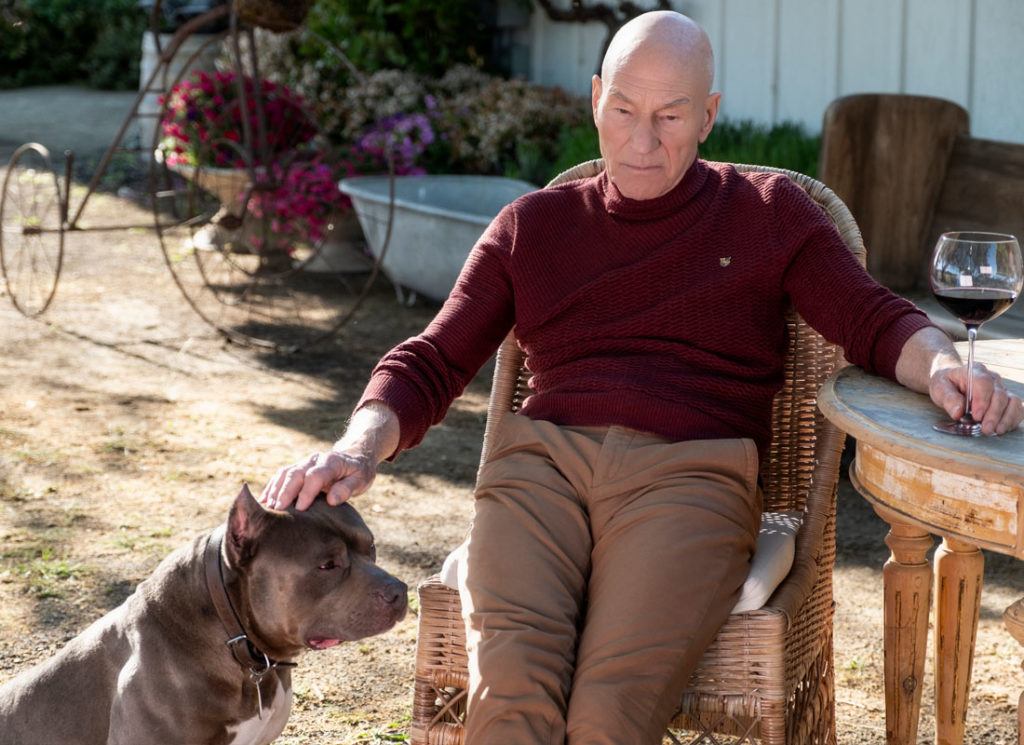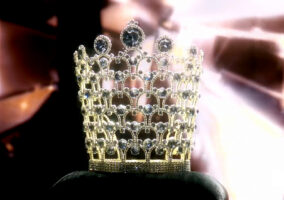
Several days ago, we had the pleasure of screening the first episode of Patrick Stewart’s return to what is arguably (because he’s got more than one on the C.V.) his most iconic character, Jean-Luc Picard, in the perhaps not-too-imaginatively titled Star Trek: Picard. We’ve watched it four or five times since (and by “we’ve watched,” we of course mean big ol’ nerdy Tom did) and while we have a ton of notes and thoughts and observations to get to, the one phrase that pops up first and most often in our musings is still just, “I don’t know how they did that.”
“Why are you stalling, Captain?”
“Because I don’t want the game to end.”
This exchange between Data and Picard in the opening scene set on Ten Forward in the old Enterprise-D, as Bing Crosby sings “Blue Skies,” which Data sang at Riker and Troi’s wedding and then left as a memory imprint on his prototype brother B-4 after he died (Hold on to the nearest LCARS station, because we are GOING IN on the Trek lore, bitches!) is more than a bit ironic and we figure that’s got to be intentional. In the very first scene of this return to one of the most celebrated sci-fi TV series of all time, the lead character is wallowing in nostalgia, not wanting anything to change or progress from this one perfect moment. Not just hearing, but sitting in and surrounded by echoes of the past. Then everything exploded.
As much as we (okay, yes: Tom) absolutely adore this character, we felt a huge sense of relief as the episode unfolded and it became clear that “pointless nostalgia” had quite clearly been eliminated as a reason for the story. The first thing we noticed was Stewart’s own performance. It’s so … small. You can look at any current media appearance by the man to see that the 79-year old is so fit and vital that it would be an insult to use the word “spry” to describe him. But it should be noted that, based on the timeline, Jean-Luc is about 10 to 15 years older than Patrick Stewart, which explains the frail affect and softened voice. Stewart could have easily given us that booming, oaken voice and regal bearing we all think of when Picard’s name comes up. It’s a choice to render him so old and to keep him so earthbound. It’s a choice to replace the usual soaring Star Trek theme with something sad and poignant, with the whiff of elegy behind it. It’s a choice to highlight that Jean-Luc’s ever-present tea-Earl-Grey-hot is now decaf.
“The dreams are lovely. It’s the waking up I’m beginning to resent.”
His Number One is a faithful dog. His “ship” the family vineyard. His “bridge crew” a pair of affectionate, teasing Romulan caregivers (which is to say, Romulans who act absolutely nothing like Romulans). Despite the gorgeousness of Chateau Picard and its surroundings, Jean-Luc’s world has been reduced in every conceivable way. This is good. This is correct. A series that opened with some sort of swashbuckling action figure or commanding Man of Authority would have been completely pointless in our eyes. Worse, it would have been a narrative dead end. We’re coming back to Picard not to see him at his height, but to pay witness to his decline, which is a much braver creative choice. This isn’t to say we should all look forward to a series about one of our favorite heroes fading away and dying. A year after Luke Skywalker shuffled off this mortal coil with blue milk in his beard and a million regrets on his ledger, we can’t imagine the creators of this show would be so foolish as to torture the nerd community that way again. No, this is a story about a man who’s been in mourning for decades — not just for Data, whose death has clearly haunted Picard all this time. He’s mourning his mistakes, his past, and the loss of the man he was. “Sitting here all these years, nursing my offended dignity” as he put it. It’s the story of a man waiting for death who finds out he still has things to do.
But make no mistake, it’s the past that fuels the story. When we wonder aloud at how showrunner/lead writer Michael Chabon and director Hanelle Culpepper managed to pull it off, what we mean is that the series is positioned as the natural end of a beloved character, a musing on the dangers of nostalgia, a near-total clearing of the decks (pun unintended) in terms of setting and supporting cast, and yet somehow still extremely connected to some of the deepest, oldest, most disparate strands of Star Trek lore. The episode starts off as a wistful elegy and ends as a call to action based on fearful and intriguing new developments that build exquisitely on the past. We reiterate: We don’t know how they did that. We can think of a thousand different ways the re-introduction of the iconic Borg cube could have come off groan-worthy or perfunctory or even cheap. This episode went the most unexpected way, dropping a bomb in the last few seconds that reveals just how deeply entrenched in past Trek lore we really are.
It’s how they synthesized those strands of Trek lore to spin out an entirely new tale that impresses us: the destruction of Romulus that kicked off the events that led to what’s been called the Kelvin timeline of the Chris Pine/Zachary Quinto Star Trek films, the fate of Data and B-4 after the events of the last film to utilize the Next Generation cast, 2002’s Star Trek: Nemesis, the Short Trek episode “Children of Mars,” which just debuted this month, Data’s long interest in creating children, specifically a daughter for himself, and most impressively, and deepest of all, going all the way back to the second season of Next Generation, when Data’s rights were put on trial by science officer and cyberneticist Dr. Bruce Maddox, whose name gets dropped several times in this episode because he appears to have done what Data couldn’t: created positronic offspring of him. And just to make sure everything’s firmly rooted in that deep, rich, Trek lore soil, one of them gets a job at the Daystrom institute and the other one works for the Romulans now occupying a seeming dead Borg sphere. For a show with only two recognizable Trek characters (one of whom appears onscreen for only a minute), that spends 90% of its first episode firmly on the ground, it really is amazing how it all feels so deeply connected to every part of the Star Trek mythology.
But from the opening attack in Dahj’s apartment, which is more raw and violent than we’re used to seeing from Trek, it’s made very clear from the jump that this will not be a look back at the world that was; the world of optimism and gleaming ships and a robustly democratic Federation backed up by a noble and heroic Star Fleet. The Romulan diaspora and the synth attack at Utopia Planitia have radically altered the once utopian society dreamed up (and rigidly insisted upon) by original Star Trek creator Gene Roddenberry. Knowledge is now restricted, research and discovery now sidelined or quietly packed away. (Quick aside: Trek shows live or die by their supporting casts and it’s a great sign that Alison Pill is very charming, has great chemistry with Stewart, and is surprisingly good at the patented Trek technobabble for a first-timer.) We imagine some hardcore fans will have a problem with that, but the idea that the optimism of decades past has been pushed aside for a darker, more violent and corrupt society is an idea that has no small amount of resonance in the current climate, which makes it very much of a piece with Trek history and style. Like the best of science fiction, Trek always attempted to reflect the world of its audience and we can’t think of anything more stirring at the moment than an old legend rising up in a corrupted world to try and make a few things right again.
Paris Fashion Week: Viktor&Rolf Spring 2020 Couture Collection Next Post:
Lizzo at the Warner Music Group Pre-Grammy Party
Please review our Community Guidelines before posting a comment. Thank you!



